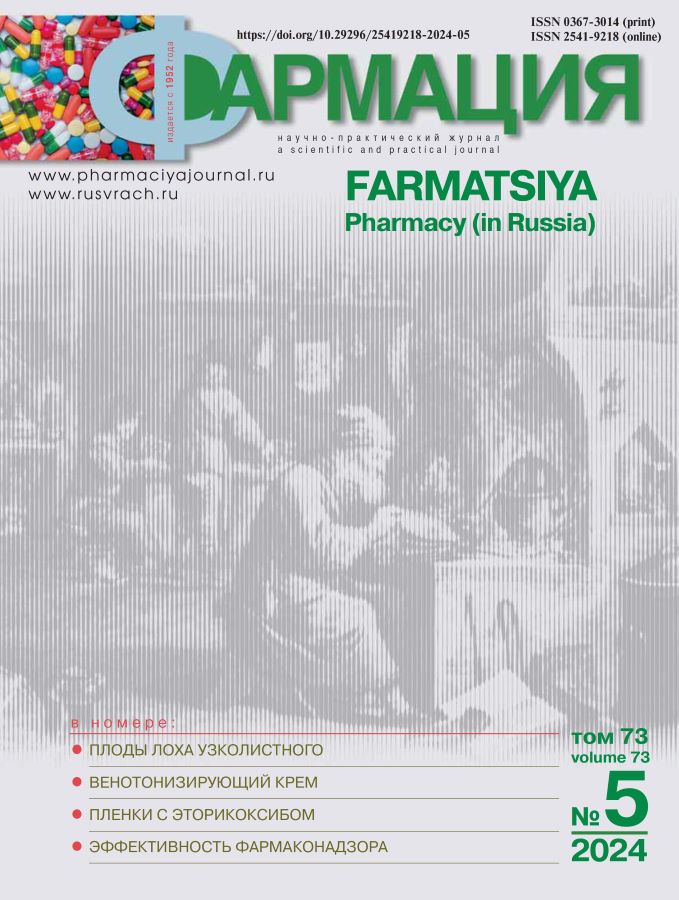Фитохимические и генопротекторные особенности экстракта мезокарпия плодов Elaeаgnus angustifоlia L.
- Авторы: Щепетова Е.В.1, Абдурахманова Н.М.1, Прокопчук Т.М.2, Кондратенко Е.И.3, Байханова О.Д.4
-
Учреждения:
- ФГБОУ ВО Астраханский государственный университет им. В.Н. Татищева
- ФГБОУ ВО Астраханский государственный университет им. В.Н. Татищева, Российская Федерация
- ФИЦ Субтропический научный центр Российской академии наук
- ГБУ Профессиональная образовательная организация «Астраханский базовый медицинский колледж»
- Выпуск: Том 73, № 5 (2024)
- Страницы: 5-13
- Раздел: Фармацевтическая химия и фармакогнозия
- URL: https://journals.eco-vector.com/0367-3014/article/view/635604
- DOI: https://doi.org/10.29296/25419218-2024-05-01
- ID: 635604
Цитировать
Полный текст
Аннотация
Введение. В современных фармакологических исследованиях описаны иммуномодулирующее и антиоксидантное действия экстрактов биологических субстанций лоха узколистного (Elaeаgnus angustifоlia L.). Изучение фитохимических и генопротекторных свойств мезокарпия этого растения, произрастающего в почвенно-климатических условиях Астраханского региона, позволит определить возможности использования плодов лоха узколистного в условиях возрастающей антропогенной нагрузки в регионе, которая неизбежно приводит к нарушению стабильности генома человека.
Цель исследования: изучение фитохимического состава мезокарпия плодов Elaeаgnus angustifоlia L.; определение антимутагенного потенциала экстракта с помощью микробной тест-системы Эймса.
Материал и методы. Плоды E. Аngustifolia собирали в Камызякском районе Астраханской области. Количественное определение флавоноидов проводили методом спектрофотометрии, основанным на способности флавоноидов экстракта мезокарпия E. Angustifolia образовывать окрашенный комплекс со спиртовым раствором хлорида алюминия (при расчете использовали калибровочный график, построенный по рутину). Содержание фенолкарбоновых кислот определяли спектрофотометрическим методом, дубильных веществ – методом комплексонометрического титрования (реактив осаждения – сульфат цинка). Количество аскорбиновой кислоты определили методом титрования подкисленного экстракта раствором 2,6-дихлорфенолиндофенолята натрия. Методом хроматомасс-спектрометрии на приборе Hewlett PackardG выявили качественный состав экстракта мезокарпия E. Angustifolia. Антимутагенную активность экстракта мезокарпия в отношении тест-штамма Salmonella t. оценили в бактериальной тест-системе Эймса путем определения степени ингибирования деятельности мутагена растительным экстрактом. Провели подсчет количества выросших his+ колоний-ревертантов в пробе с азидом натрия и экстрактом в сравнении с контрольными данными.
Результаты. В мезокарпии E. Angustifolia выявили: флавоноиды (4,2%), фенолкарбоновые кислоты (5,2%), гидролизуемые дубильные вещества (6,7%), аскорбиновую кислоту (2,3%), алифатические кислоты (свободные и связанные: вакценовую, линолевую, эйкозановую и др.), спирты (фитол, гексадеканол, эйкозенол и др.), углеводороды (пентадекан, докозан и др.).
Заключение. Экстракт мезокарпия плодов E. angustifólia L. проявил умеренную антимутагенную активность в бактериальной тест-системе Эймса.
Полный текст
Об авторах
Екатерина Владимировна Щепетова
ФГБОУ ВО Астраханский государственный университет им. В.Н. Татищева
Автор, ответственный за переписку.
Email: af_chem@asu.edu.ru
ORCID iD: 0000-0002-3858-0229
кандидат биологических наук, доцент, доцент кафедры фундаментальной и прикладной химии
Россия, 414000, Астрахань, пл. Шаумяна, 1Нурия Мулдагалиевна Абдурахманова
ФГБОУ ВО Астраханский государственный университет им. В.Н. Татищева
Email: af_chem@asu.edu.ru
ORCID iD: 0000-0003-4640-8282
кандидат химических наук, доцент, доцент кафедры фундаментальной и прикладной химии
Россия, 414000, Астрахань, пл. Шаумяна, 1Татьяна Маратовна Прокопчук
ФГБОУ ВО Астраханский государственный университет им. В.Н. Татищева, Российская Федерация
Email: physiology-agu@asu.edu.ru
ORCID iD: 0000-0001-6080-2257
бакалавр агробиологического факультета
Россия, 414000, Астрахань, пл. Шаумяна, 1Елена Игоревна Кондратенко
ФИЦ Субтропический научный центр Российской академии наук
Email: subplod@mail.ru
ORCID iD: 0000-0002-8988-5022
доктор биологических наук, профессор, заведующая лабораторией молекулярно-генетических исследований
Россия, 354002, Сочи, ул. Яна Фабрициуса, д. 2/28Оксана Джумагалиевна Байханова
ГБУ Профессиональная образовательная организация «Астраханский базовый медицинский колледж»
Email: mail@abmk.edu.ru
ORCID iD: 0009-0005-9070-6502
преподаватель, заведующая Учебным отделением 1
Россия, 414057, Астрахань, ул. Н. Островского, д. 111Список литературы
- Платкова Т.Н., Кирютина А.И., Степаненко И.С., Ямашкин С.А. Исследование мутагенного потенциала производных замещенных 1Н-индол-4-,6-, 7-иламинов в тесте Эймса Salmonella/микросомы. Современные проблемы науки и образования. 2021; 4. [Platkova T.N., Kiryutina A.I., Stepanenko I.S., Yamashkin S.A. Mutagenic Potential Study of Substituted 1H-Indole-4-,6-, 7-ylamines in Ames Salmonella/Microsome Test. Sovremennye problemy nauki i obrazovaniya. 2021; 4. url: https://science-education.ru/ru/article/view?id=31021 (in Russian)]
- Hamidpour R., Hamidpour S., Hamidpour M., Shahlari M., Sohraby M., Shahlari N. Russian olive (Elaeagnus angustifolia L.): From a variety of traditional medicinal applications to its novel roles as active antioxidant, anti-inflammatory, anti-mutagenic and analgesic agent. Journal of Traditional and Complementary Medicine. 2016; 7 (1): 24–9. doi: 10.1016/j.jtcme.2015.09.004
- Сальникова Н.А., Шур Ю.В., Цибизова А.А. Фитохимический анализ листьев лоха серебристого Elaeagnus argentea. Разработка и регистрация лекарственных средств. 2021; 10 (3): 95–9. https://DOI.org/10.33380/2305-2066-2021-10-3-95-99. [Sal`nikova N.A., Shur Yu.V., Tcibizova A.A. Phytochemical analysis of silvery loch leaves by Elaeagnus argentea. Razrabotka i registratsiya lekarstvennykh sredstv. 2021; 10 (3): 95–9. https://DOI.org/10.33380/2305-2066-2021-10-3-95-99 (in Russian)]
- Иващенко Н.В., Самылина И.А., Лапшихина А.А. Изучение полифенольного комплекса лоха узколистного, произрастающего в России. Фармация. 2014; 7: 16–9. [Ivashhenko N. V., Samylina I. A., Lapshikhina A. A. Study of polyphenol complex of narrow-leaved loch growing in Russia. Farmatsiya. 2014; 7: 16–9 (in Russian)].
- Monjazeb Marvdashti L., Maryam Mohammadbeigi M., Arab S., Ebrahimi A., Rezaei A., 6, Abdolshahi A. Elaeagnus angustifolia L. Whole Fruit Ethanolic Extract: Phytochemical Composition and Antimicrobial Effects. J. of Chemical Health Risks. 2023; 13 (0). doi: 10.22034/jchr.2022.1899059.1130
- Кудашкина Н.В., Хасанова С.Р., Мещерякова C.А. Фитохимический анализ: учеб. Пособие. Уфа, 2019; 193. [Kudashkina N.V., Khasanova S.R., Meshheryakova C.A. Phytochemical Analysis: tutorial. Ufa, 2019; 193 (in Russian)].
- Методические рекомендации: «Методы оценки антиоксидантной, антибактериальной и антимутагенной активности биологически активных веществ растительного происхождения». Мин-во здравоохранения республики Беларусь: Минск, 2018; 007–1018: 27. [Methodological recommendations: "Methods for assessing antioxidant, antibacterial and antimutagenic activity of biologically active substances of plant origin". Min-vo zdravookhraneniya respubliki Belarus': Minsk, 2018; 007–1018: 27 (in Russian)].
Дополнительные файлы











